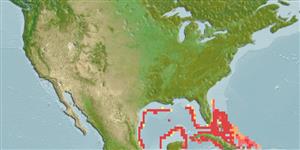Elasmobranchii (sharks and rays) >
Carcharhiniformes (Ground sharks) >
Scyliorhinidae (Cat sharks) > Scyliorhininae
Etymology: Scyliorhinus: skylion, Greek for dogfish or small shark; rhinus, from rhine (Gr.), rasp, alluding to a shark’s jagged, rasp-like skin (See ETYFish); torrei: In honor of Cuban zoologist Carlos de la Torre (1858-1950), who recognized this species as new and granted Howell Rivero permission to study and describe it (See ETYFish).
Eponymy: Professor Carlos de la Torre y la Huerta (1858–1950) of Havana University was a malacologist regarded as the foremost Cuban naturalist of his generation. [...] (Ref. 128868), visit book page.
Environment: milieu / climate zone / depth range / distribution range
Ecology
Marine; bathydemersal; depth range 200 - 600 m (Ref. 55584), usually 366 - 550 m (Ref. 244). Deep-water; 30°N - 20°N
Western Central Atlantic: southern Florida (USA), Bahamas, and Cuba.
Size / Weight / Age
Maturity: Lm ? range ? - ? cm
Max length : 32.0 cm TL male/unsexed; (Ref. 244)
Broad rounded snout. Pale brown back and upper sides transversely marked by series of indistinct darker blotches. Finer markings consist of small oval whitish spots, evenly distributed over the whole back and upper sides (Ref. 6032).
Found on the upper continental slope. Little is known of its biology. Oviparous (Ref. 50449).
Life cycle and mating behavior
Maturity | Reproduction | Spawning | Eggs | Fecundity | Larvae
Oviparous, paired eggs are laid. Embryos feed solely on yolk (Ref. 50449).
Compagno, L.J.V., 1984. FAO Species Catalogue. Vol. 4. Sharks of the world. An annotated and illustrated catalogue of shark species known to date. Part 2 - Carcharhiniformes. FAO Fish. Synop. 125(4/2):251-655. Rome: FAO. (Ref. 244)
IUCN Red List Status (Ref. 130435: Version 2024-2)
Threat to humans
Harmless
Human uses
Fisheries: of no interest
Tools
Special reports
Download XML
Internet sources
Estimates based on models
Preferred temperature (Ref.
123201): 9.3 - 16.2, mean 13 °C (based on 33 cells).
Phylogenetic diversity index (Ref.
82804): PD
50 = 0.5000 [Uniqueness, from 0.5 = low to 2.0 = high].
Bayesian length-weight: a=0.00263 (0.00138 - 0.00502), b=3.21 (3.04 - 3.38), in cm total length, based on LWR estimates for this (Sub)family-body shape (Ref.
93245).
Trophic level (Ref.
69278): 3.7 ±0.5 se; based on size and trophs of closest relatives
Resilience (Ref.
120179): Very Low, minimum population doubling time more than 14 years (Fec assumed to be <10).
Fishing Vulnerability (Ref.
59153): Low vulnerability (22 of 100).
